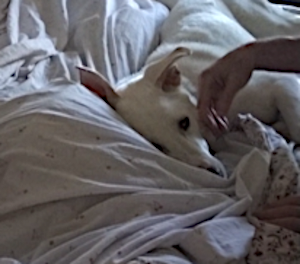
My daughter's dog is wildly playful. He is young, just 14 months old. His rambunctious nature is due not only to his youth, but to his heritage. According to his shelter documents, he is a mixed breed with a background in feisty, strong-headed dogs. And yet, during the day hours, when I babysit for this energetic pet, he is gentle and affectionate. Gone are the behaviors evident when my daughter, granddaughter and son are with him--jumping, leaping, yipping, pawing.
Here is the dog being feisty. He is out in the backyard and is tossing a swimming pool around.
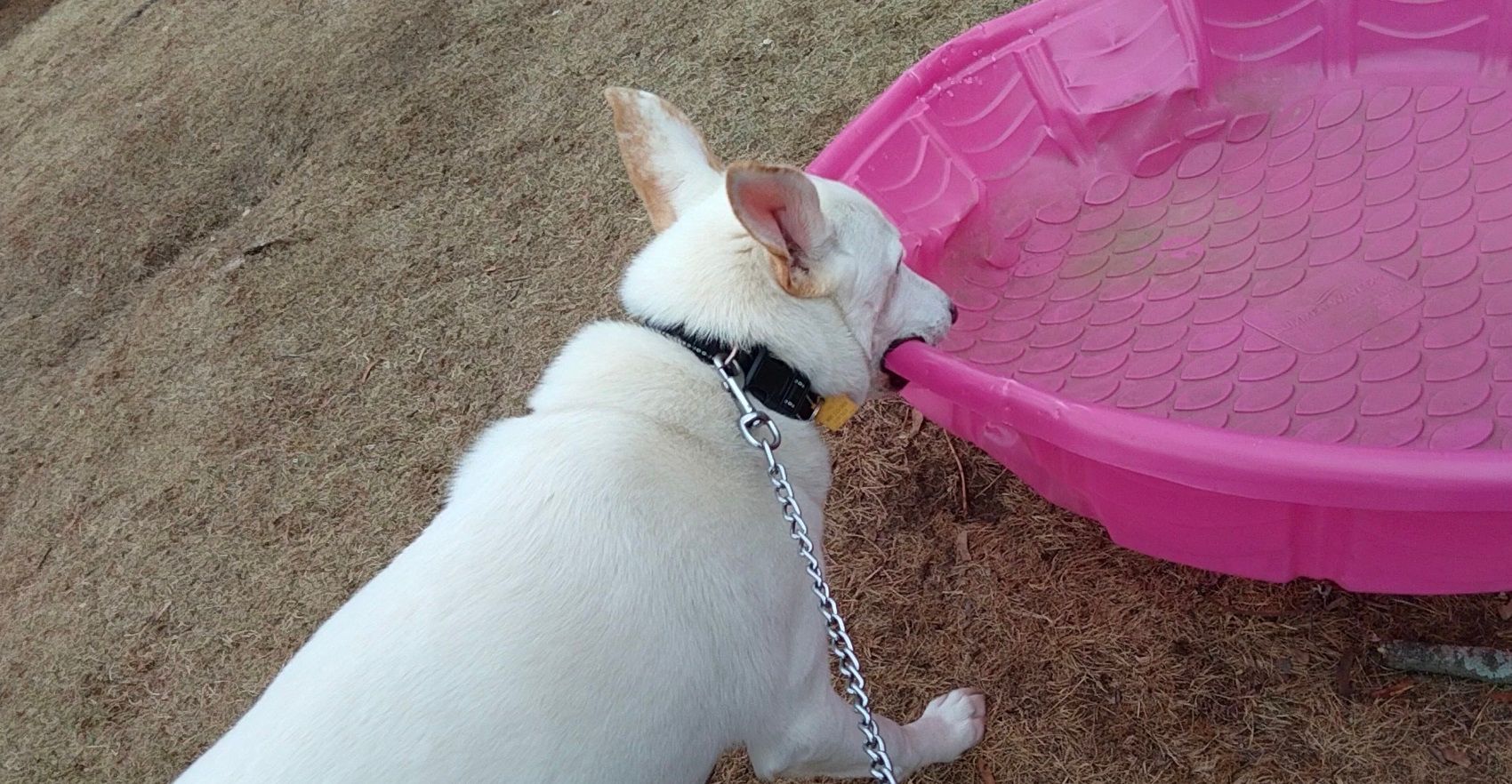
Look at the picture that heads this blog. The image is a still, captured from a short video I shot with my phone. My husband is petting the dog. You can see that the dog is in a groove, communicating with my husband. The dog is quiet when he is with me also, but he is quietest when he is with my husband. We are both fairly old, but my husband has been dealing with some health issues. How does the dog know that?
The picture below is another still captured from the video. (Note: That is my bed. A sheet is put down every day for the dog and cat to sit on.)
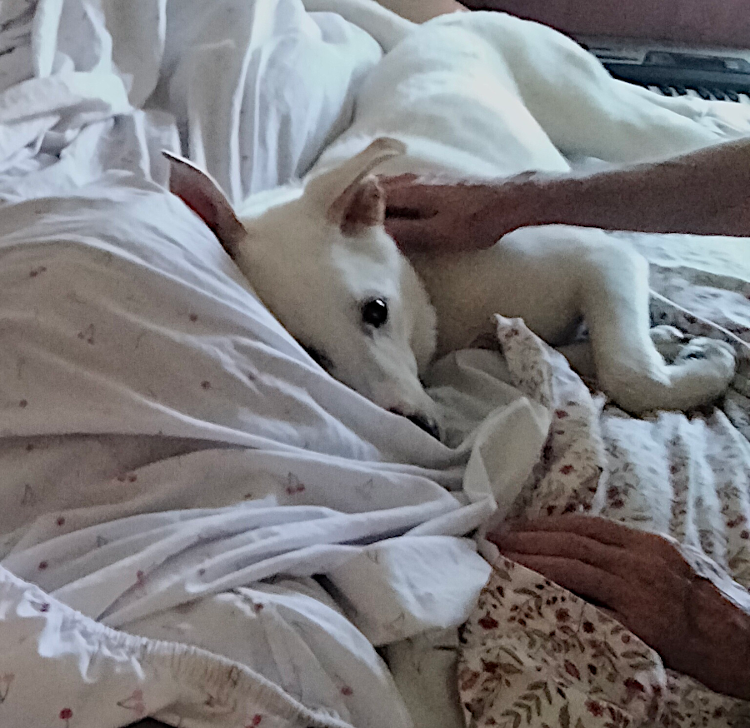
I told my daughter I thought her dog was very smart, because of the way he is able to adapt his behavior to different people. I'm amazed that he can read us as he does. My daughter responded that all dogs are smart. All dogs can do that. So I started doing a little research.
I found an article from a scholarly journal, Evolutionary Human Sciences that explores how dogs use emotional information they observe in human expressions. The authors of this article explain that not only humans, but other animals also "...rely on emotions perception to guide their behavior..." The social success of these animals (and humans) depends on their ability to gauge emotions in others.
Dogs, domesticated thousands of years ago, have learned how to read not only the expressions of their fellow dogs, but also of humans. And, according to this article, by "acquiring information they obtain from faces and body postures", dogs are able to make decisions.
I still think my daughter's dog is really smart, because of the degree to which he is able to 'read' us, and to change his behavior...almost on a dime. I was tired one afternoon and thought I'd like down for a while. The dog usually appropriates the bed in the afternoons but I made a small place for myself on his sheet. He looked a little confused. He'd never seen me do that before. Then he did this.
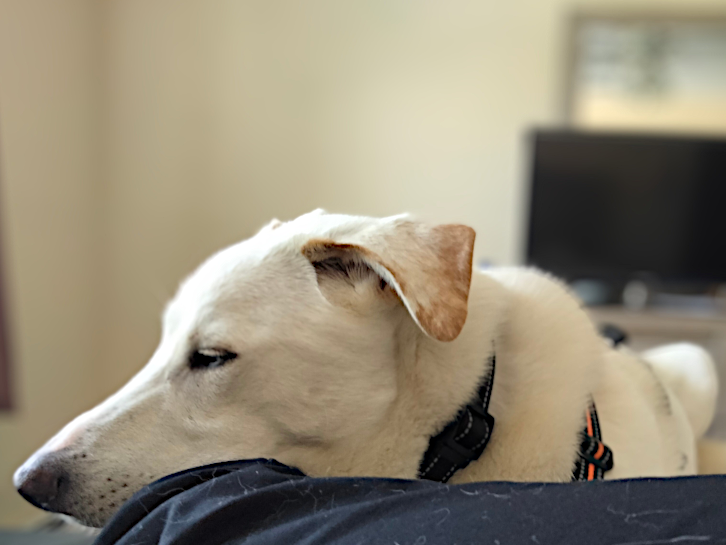
He rested his head on my leg and took a snooze. (Notice the fur on my pants!)
That is a very adaptable dog. Also very sweet.
I walk the dog at least twice a day when I am babysitting. In the picture below we are relaxing out in the backyard. When my daughter, son and granddaughter take him in the backyard they call him 'white lightning' because he runs around the yard so fast. He leaps over barriers, like a pony jumping over hurdles.
When I take the dog out in the backyard, we walk around casually. He sniffs the ground, the fence, the deck and plants. Then we sit down, for maybe ten or fifteen minutes. Here is a picture of him taking in the sun and the air with me.
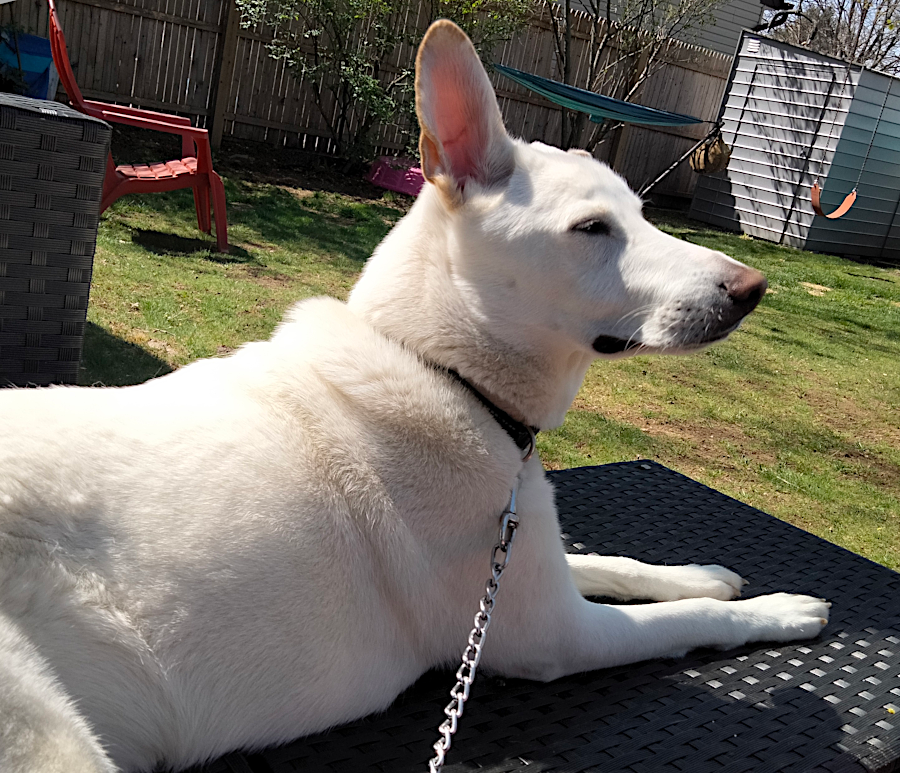
Another article I read (Frontiers in Psychology) looked at the influence that gaze has on animal behavior. The article considers gaze not only in dogs but also in cats. The authors of the article discuss how these two species became domesticated.
Cats became domesticated because, as hunters of pests, they were useful to the household. Cats lived near humans. Dogs, on the other hand, lived with humans. The animals "acquired social tolerance to humans and cooperated with humans by assisting in hunting and guarding."
The domestic dog is descended from wolves. Domestic cats are descended from wildcats. The wolf is a social animal (within its own species), whereas the wildcat is "solitary and territorial". Wolves use gaze to communicate with each other. Dogs use gaze to communicate with other dogs, and also with humans. That's what the authors of this article assert, anyway.
The dog is not so calm with my daughter's cat. They do a lot of 'gazing', if staring across the room at each other is 'gazing'. Every now and then they go head to head. I think the dog wants to make friends, but his idea of friendship includes rough play and the cat seems to understand that would be the end of him.
Here is a picture of the two of them. The dog has just jumped up on the bed and I think he's hoping to play. The two are gazing at each other. I'm sure the cat is warning him off, and I'm sure the dog is entreating the cat to engage in a game.
That's not how the encounter went.
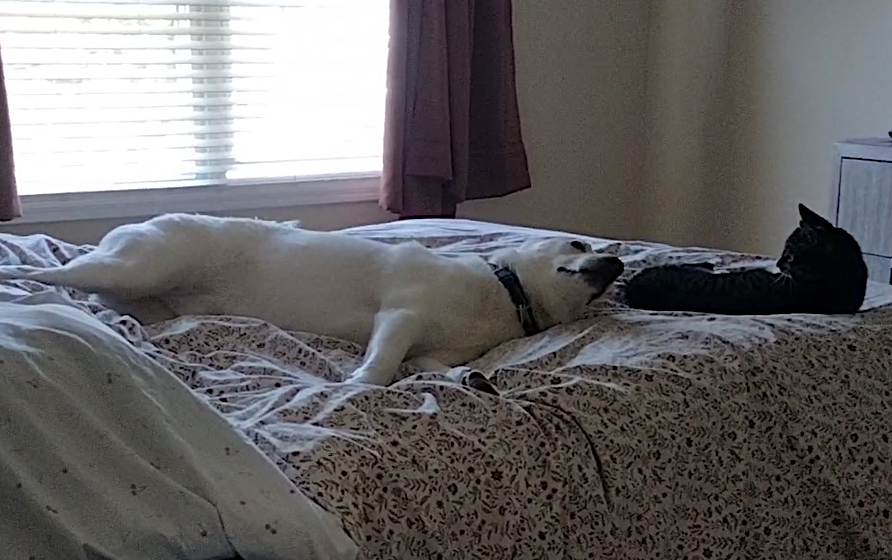
Here is how that encounter proceeded from there. These are still images I captured from a video I shot with my phone.
The dog gets up and advances his cause. "Let's play!" The cat is having no part of it. Instinctively the cat probably knows that 'play' with this large beast would not end well for him. With raised paw and claws exposed he warns the dog off.
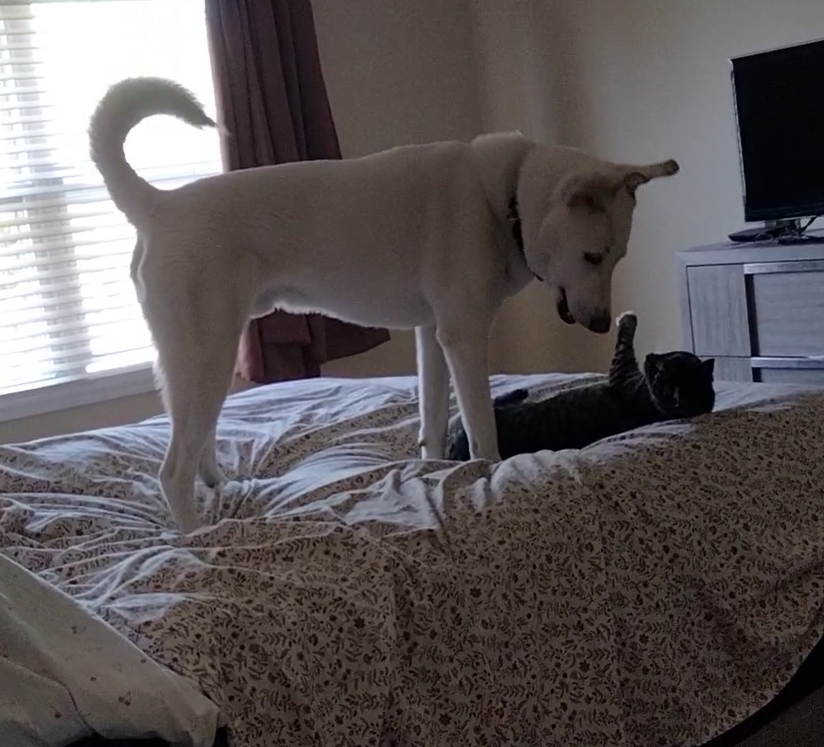
Maybe the dog isn't that smart because this sequence has played out time and time again. The dog advances and the cat swats.
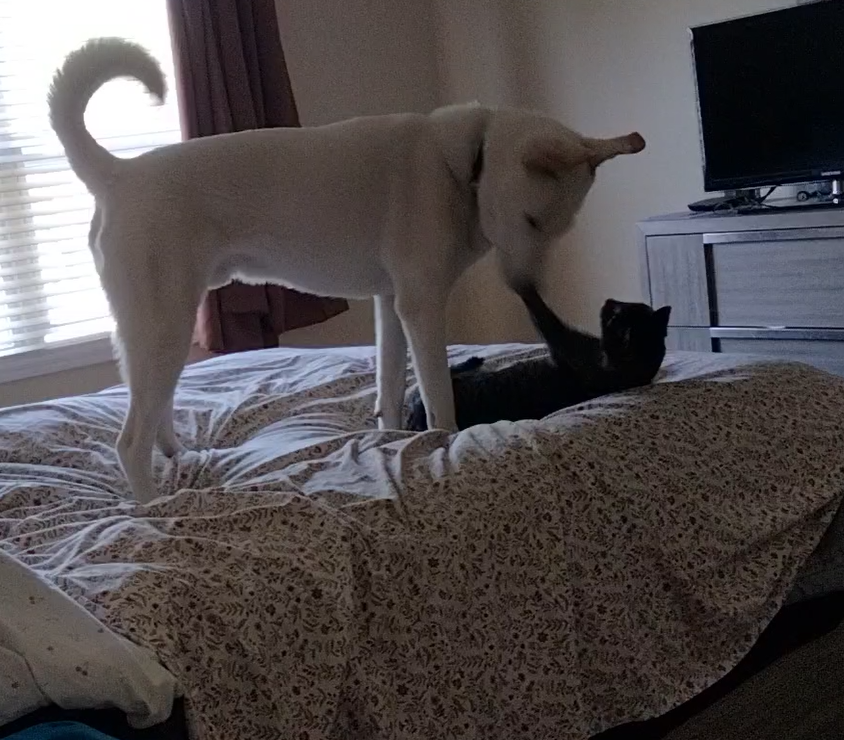
Ouch! That hurts. All four claws and teeth engaged now. The dog is warned and smart enough to leave this fray.

The dog, feelings and nose wounded, regards the cat cautiously and the cat affirms his defensive posture.

It's over. The dog knows he's lost. The cat knows he's won. He begins to relax.
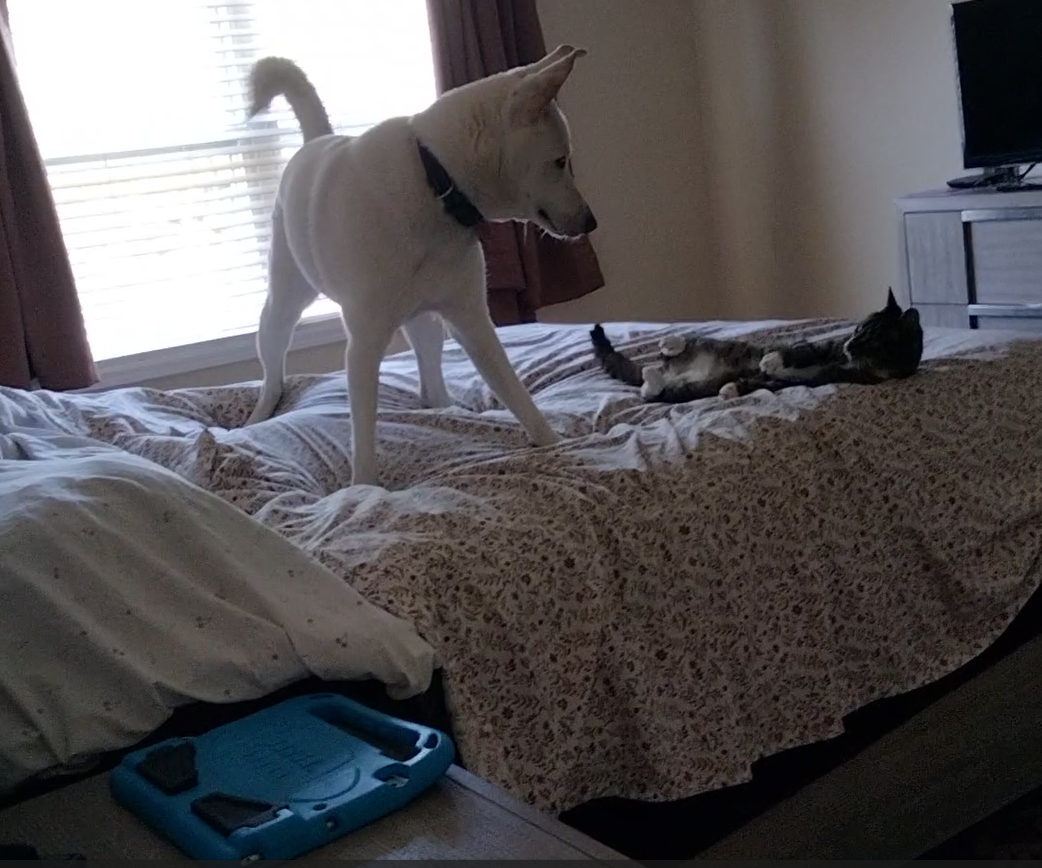
Shortly after this the cat apparently decided fighting for a place on the bed wasn't worth his trouble. He walked off and went to sit on a rug in the corner of my husband's office. There he knew he would not be molested.
Is my daughter's dog smart? I think so. Is yours? Does yours read people so well? Is your dog both playful and gentle? I hope so.
Thank you for reading. Sharing these pictures and writing about these lovely animals is always a positive experience.
Peace and health to all.
All photos were taken by me.